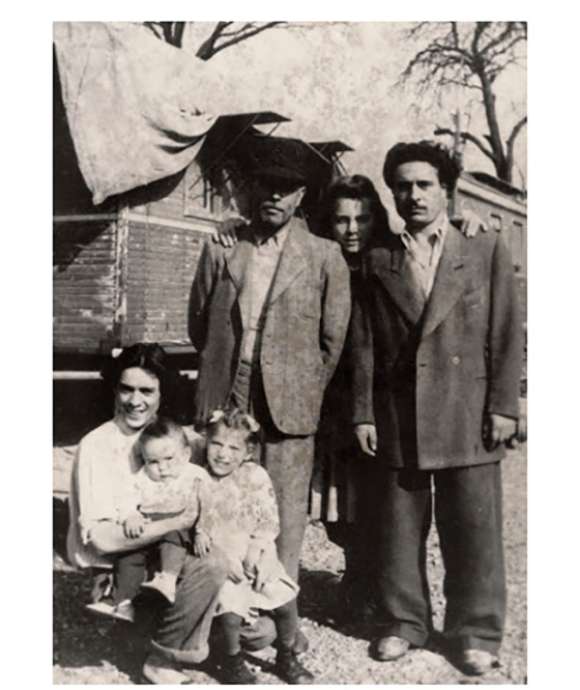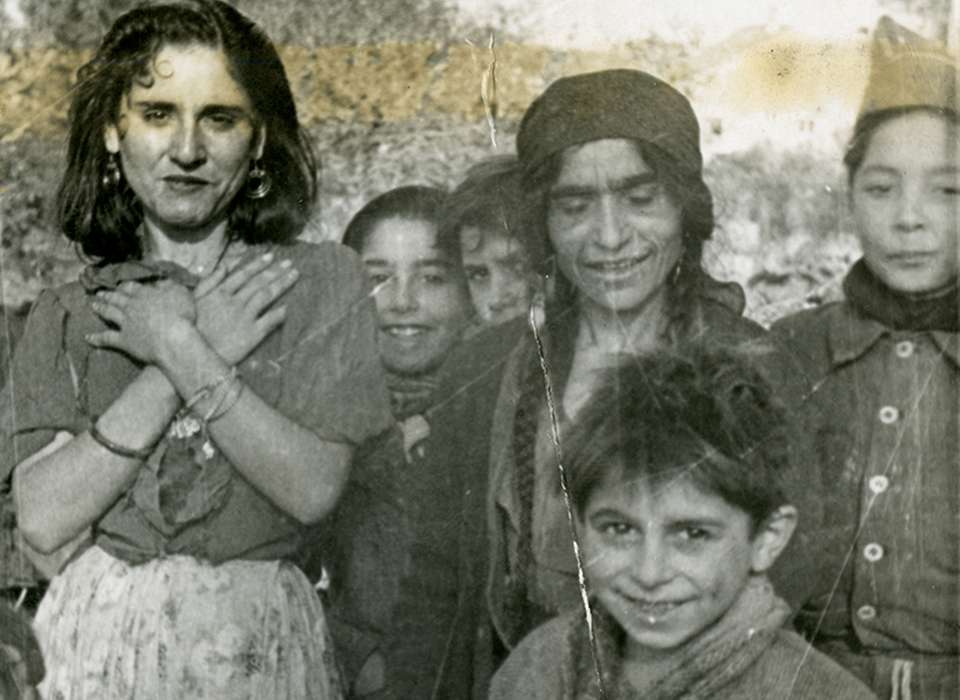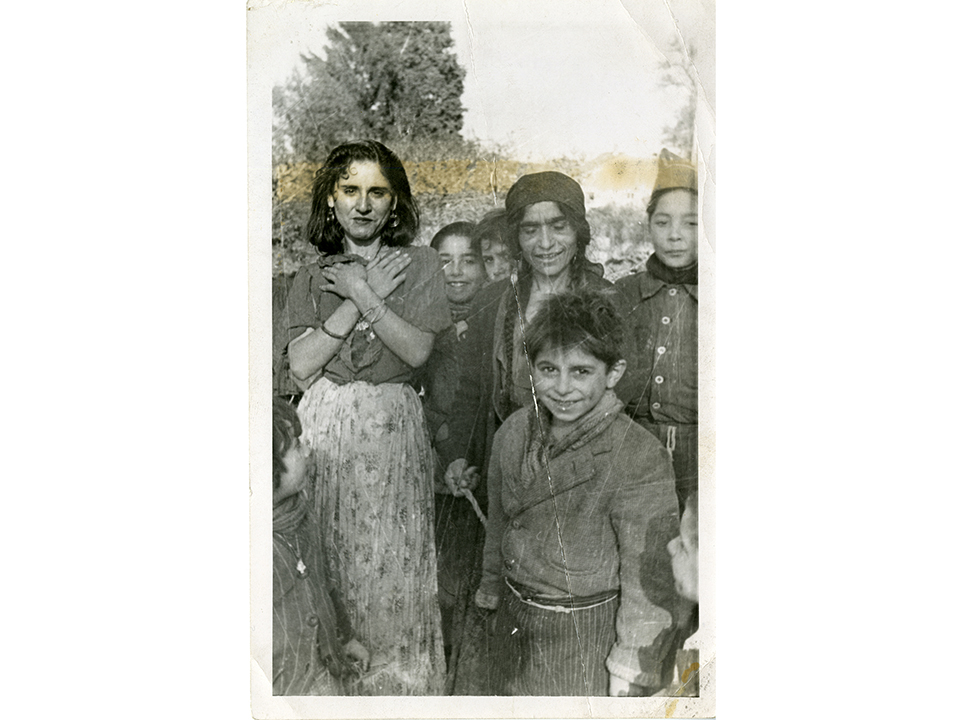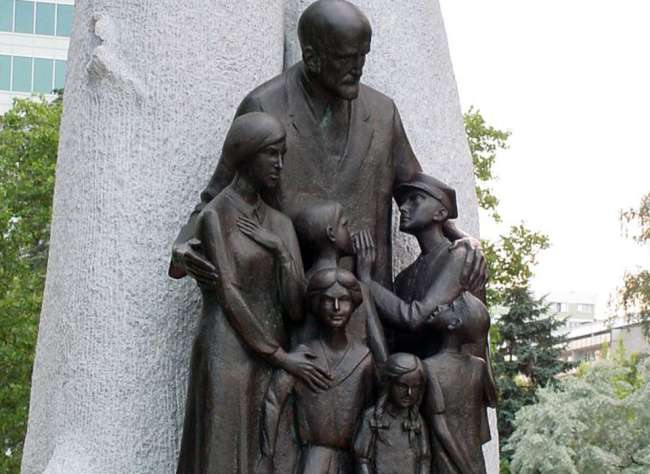German Photograph of Family of Roma, Marseilles, France, November 1942. Gift of Mrs. Patty Millett, from the Collection of The National WWII Museum, 2011.403.132.
It is frequently said in discussions about the enormity of the Third Reich’s crimes that there is insufficient attention to the mass murder of Roma. This is indisputably true. Yet it is misleading to merely add several hundred thousand Romani victims to the six million Jews annihilated by the Nazi terror apparatus. The deaths of these men, women, and children, murdered as “Gypsies,” cannot be reckoned in terms of an “also,” an “in addition to,” or “it cannot be overlooked that. . . .” One must not consider their destruction as an addendum to the Judeocide at all. While the Hitler regime’s targeting of Roma in several European countries during World War II coincided and intersected with the Holocaust, the former derived from a form of racism distinct from genocidal anti-Semitism. To understand anti-Roma racial hatred, one must examine the longer history of Roma in European culture. This article, the first of a series, prepares the groundwork for such an inquiry.
At the outset, it is important to challenge some long-held and deeply entrenched stereotypes and misnomers about Roma or, more precisely, Roma and Sinti (often “Roma” is used as a category encompassing both). The place to begin with challenging these falsehoods is with the very word “Gypsy.” Now mainly deemed a slur, the English “Gypsy,” like the Spanish “Gitano,” reveals an old, false assumption: that this is a people who originated from Egypt. Historical research has long refuted this belief. Roma and Sinti can be traced back to India, to the Punjab region. The Romani language (the source for the appellation “Roma”) is related to Sanskrit. More than a thousand years ago, they began to migrate out of India, heading westward in successive waves. They crossed the Middle East and arrived in continental Europe in the later Middle Ages.
Political scientist Guenter Lewy claimed that evidence of the Roma in Greece dates to the fourteenth century, during the late Byzantine period. The Greek term “Atzinganoi” was coined to classify them. Records exist showing their arrival in Central Europe a century later. “Atzinganoi” is the basis for the German “Zigeuner,” as well as for the Italian “Zingari” and French “Tsinganes.” It must be noted, though, that this root word really translates as “untouchable.” Here language reveals a brutal social hierarchy with Roma condemned to pariah status. How did this occur?
It is not a simple question to answer. Certainly, a key factor shaping the attitudes of Europeans was the itinerant lifestyle so many Romani families practiced during those times. They moved from locale to locale, which engendered an aura of mystery and suspicion about them. Ugly stereotypes formed already in the late medieval/early modern period. “Gypsies” were considered dirty, deceitful, too lazy to work, and prone to steal. The most heinous accusation was that they kidnapped the young, a charge frequently hurled against Jews as well.
Several of these stereotypes clearly derive from the nomadism of Roma. Staying together in their famous caravans, Europeans came to equate them with vagabonds. Moreover, with their distinctive dress and language (Roma and Sinti spoke different dialects of the Romani language), their culture, even if they professed faith in Christianity, was often reviled as something alien and unwanted. Socio-economic factors also played a major role. Roma were known for centuries for their skill as metalworkers and for basket-making. Local guilds often resented this type of competition from outside their ranks. Economic action by these guilds may well have pushed Romani men and women to engage in acts of petty crime, like theft, to stay afloat. The willingness of Roma to engage in fortune-telling to make money also caused further hostility, though these fortune-tellers certainly enjoyed plenty of non-Romani patrons.
Animus against Roma led to a wave of decrees and edicts. Religious conflict within Europe (the Protestant Reformation) and invasions of the continent by the Ottoman Turks certainly exacerbated the enmity. In 1498, the Holy Roman Emperor Maximilian I ordered the expulsion of Roma, accusing them of supporting the Turks (some Roma had converted to Islam in areas under Ottoman control). However, the order was not stringently enforced. Many more such acts followed. According to Jennifer Illuzzi, between 1551 and 1774, rulers in the German lands passed more than 130 laws against Roma.
The spread of Enlightenment ideas concerning the “rights of man” and the impact of the Great French Revolution worked against the older hostility to Roma. Although one should not romanticize this period—notions of exclusion and expulsion began to give way to a still problematic notion of “improvement”—it was definitely a more open and humane socio-political environment for Roma in much of Central and Western Europe. In Eastern Europe it took longer. For example, well into the nineteenth century, Roma were enserfed in parts of the Habsburg Empire (serfdom was abolished there during the 1848 Revolution) and enslaved in Wallachia and Moldavia (present-day Romania).
Still, one can discern a new fascination with Romani culture at the same time, an outgrowth of the Romantics’ investigation of folk traditions. The brilliance of Romani music and dance did not go unnoticed. Hungarian composer Franz Liszt published a hugely influential book on their music in 1859. In Austria, Johannes Brahms utilized Romani melodies for his beautiful “Hungarian Dances” (1869, 1880). Deeper reasons beyond appreciation for great art furthered this fascination.
With the spread of industrial capitalism from the United Kingdom to elsewhere in Europe, and, quickly, around the globe came factories, mechanized labor, time-discipline, and extremely long working days (until efforts to reduce working hours had some success). The Romani life of restless movement soon appealed to many who felt alienated by this new capitalist order. Many European (and later North American) artists and intellectuals saw Romani culture as free-spirited and closer to nature and idealized its wanderer’s existence. This was as much a projection of their own discontent as it was a serious effort to understand a culture on the margins of the dominant socio-economic system.
Attraction to Roma mixed with the older suspicion and hostility in explosive ways. It is particularly visible in Georges Bizet’s famous opera, Carmen. First performed in Paris in 1875, it tells the story of a Spanish soldier Don José, who falls in love with the fiery Carmen, a dazzling Romani dancer. Ultimately, he abandons his childhood sweetheart for her. Yet Carmen gives her love to another, Escamillo. In a rage, Don José kills her. This fusion of allure and deceit in Carmen has packed audiences into concert halls and movie theaters (there have been several movie versions of it) for generations. Parts of the opera, argued Marxist social thinker Theodor W. Adorno, express an “envy of the colorful and unfettered lives of those who are outlawed from the bourgeois world of work, condemned to hunger and rags and suspected of possessing all the happiness which the bourgeois world denies itself in its irrational rationality.” Nonetheless, the old resentment toward and distrust of Roma assert themselves in Carmen.
Betty Schwartzberg Jacobs Dancing as Carmen, US Home Front, 1942-45. Gift of Betty Schwartzberg, from the Collection of The National WWII Museum, 2009.346.004.
This dynamic of fascination and hatred, still relatively new in European history, entered a new phase in the last third of the nineteenth century with the emergence of race theory. The attempt by race thinkers like Arthur de Gobineau and Houston Stewart Chamberlain to divide humans into distinct races within frameworks of superiority and inferiority, the effort to explain culture and behavior by recourse to biology, and the fear of “race-mixing” would have terrible consequences for Romani communities. In the next article in this series, I will look at just how these consequences unfolded.

The Bavarian Precedent: The Roma in European Culture
Prior to 1933, Bavarian authorities devised an entire system for policing and persecuting Roma.
Jason Dawsey, PhD
Jason Dawsey, PhD, is ASU WWII Studies Consultant in the Jenny Craig Institute for the Study of War and Democracy.
Cite this article:
MLA Citation:
APA Citation:
Chicago Style Citation:









![Max Fuchs, New York City cantor, sings as Rabbi Sydney [sic] Lefkowitz, Richmond, VA, conducts the first Jewish services from Germany.](/sites/default/files/styles/max_650x650/public/2025-10/image1.jpg)

